2021 Ford Mustang Mach-E vs. 1967 Ford Mustang: Compare Eras
In 1964, Ford introduced a car that made style and sport affordable and desirable to the masses. In 2020, Ford launched an electric car that made style and sport affordable and desirable to the masses. This is why 56 years and six generations later, Ford bequeaths the Mustang—it’s longest running nameplate—on the 2021 Ford Mustang Mach-E electric crossover SUV.
The goal of affordability and accessibility started more than a century ago, in 1908 with the launch of the Ford Model T. Numerologists may identify a deeper, cyclical connection: The Model T preceded the Mustang by 56 years; the Mustang preceded the Mach-E by 56 years (the first Mach-Es went on sale last year). At Ford, evolution comes every 56 years. Regardless of your belief system, each vehicle represents the zeitgeist of a cultural crossroads. We took two of them to that intersection to gauge automotive evolution against the more glacial pace of human evolution.
Representing the Electrified Age was the 2021 Ford Mustang Mach-E, which was also our Best Car To Buy 2021. My dad’s 1967 Ford Mustang represented the Industrial Age. Why a 1967? Because that’s the year my dad turned 16 and that’s what I had access to.
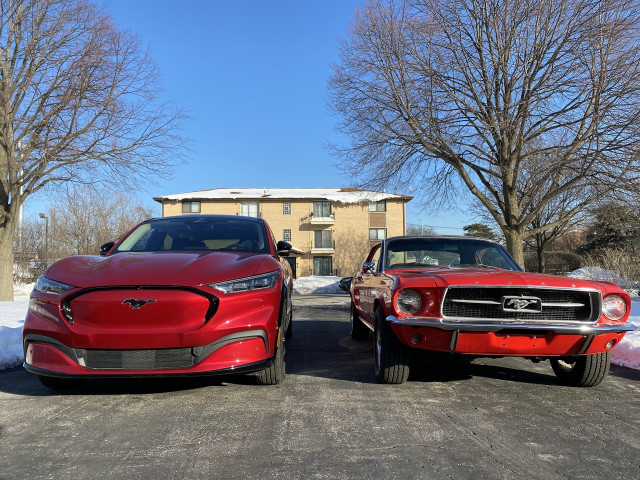
2021 Ford Mustang Mach-E and 1967 Ford Mustang coupe
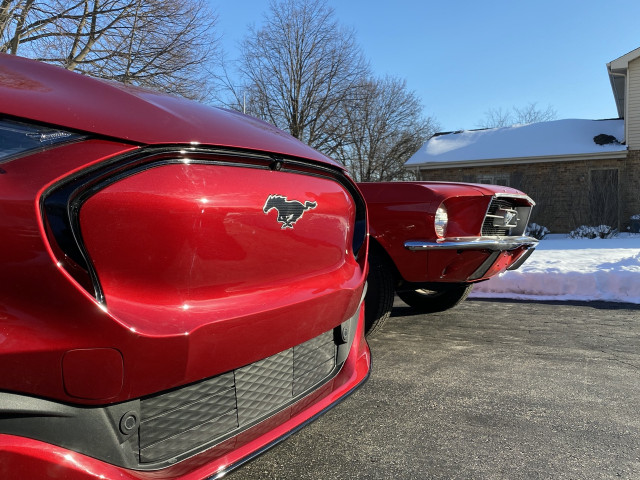
2021 Ford Mustang Mach-E and 1967 Ford Mustang coupe
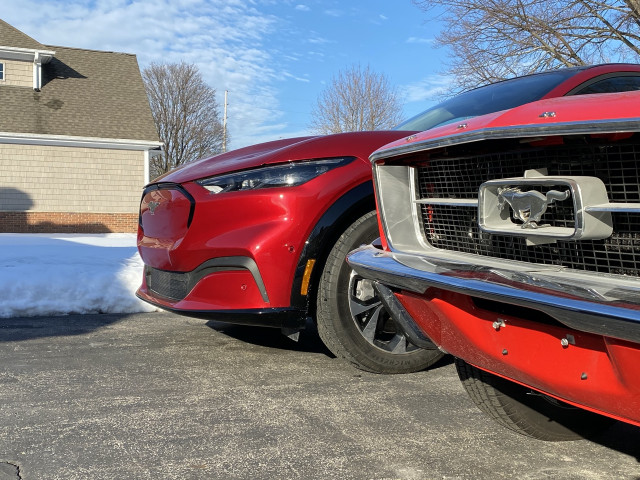
2021 Ford Mustang Mach-E and 1967 Ford Mustang coupe
Like spying a Yeti in the woods or the monster in the Ness, I caught the ’67 Mustang in Candy Apple Red basking in the rare winter sunshine. Spotting the Mustang and the sunshine is a rare thing in Chicago winters, as this garage queen rarely dares to tiptoe around salt patches until the grass is green and the roads are clean.
I pulled up in my tester, a 2021 Mustang Mach-E Premium AWD in Rapid Red Metallic.
The ’67 already had the edge in colorful naming, and the 18-inch Cragar wheels made more of an indelible rubber mark than the Mach-E’s 19-inch aluminum alloys. Both were red, both wheels had a five-petal metallic flower design.
The Mustang is a proper coupe, while the Mustang Mach-E is a four-door crossover. The galloping pony stamped on the crossbar of the ’67’s grille is darkened to black on the Mach-E’s solid front nose. Both have push button door handles, but the Mach-E’s soft-touch buttons hide next to the door frame in the name of aerodynamics. The pressure-based closing mechanisms on the Mach-E’s doors likely have more electronic sophistication than most anything on the ’67. This is one reason grease monkeys like my dad will always have a soft spot for classic cars: he can fix it himself without monkeying around with a central nervous system.
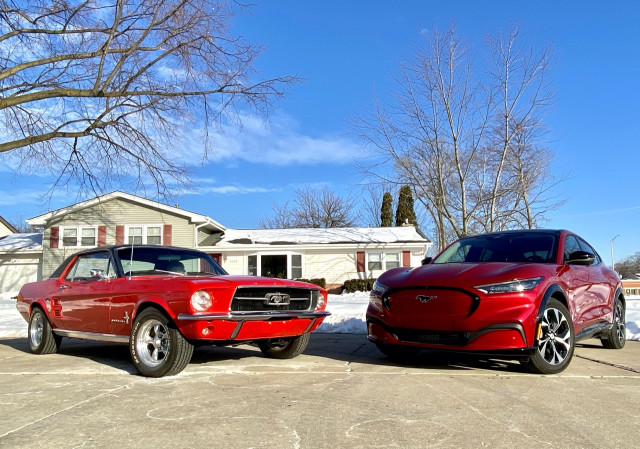
2021 Ford Mustang Mach-E and 1967 Ford Mustang coupe
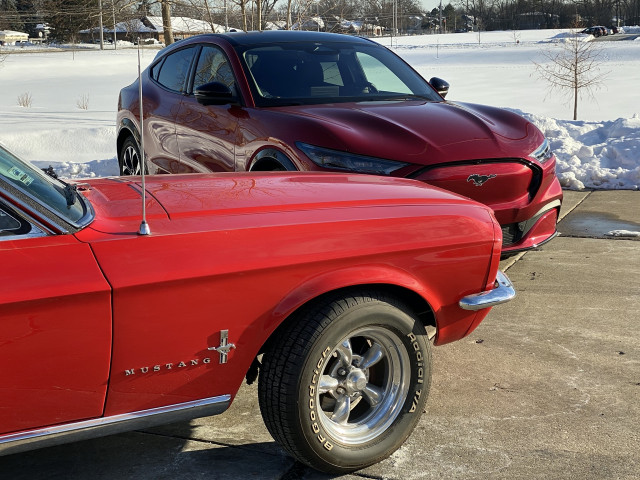
2021 Ford Mustang Mach-E and 1967 Ford Mustang coupe
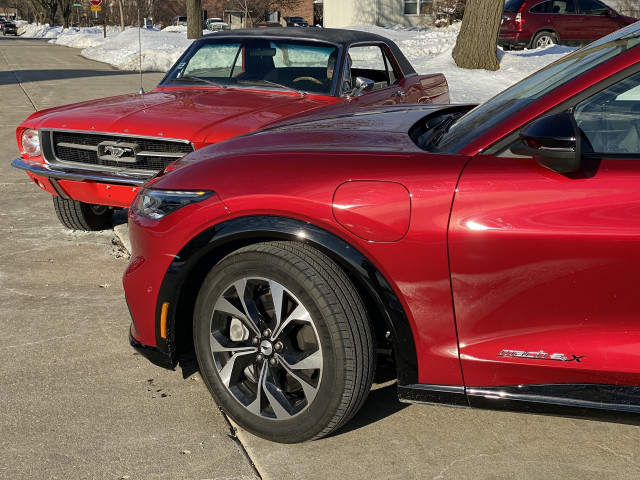
2021 Ford Mustang Mach-E and 1967 Ford Mustang coupe
The Mach-E retains key Mustang design elements such as a long hood, a short front overhang, and muscular haunches with flared wheel arches. But the Mach-E tones its muscle with curves, despite being so much bigger.
At 185.6 inches overall, however, the Mach-E is only 2.0 inches longer than the ’67 Mustang hardtop coupe, making its 29.7 cubic feet of cargo capacity behind the rear seat or 59.7 cubic feet with the 60/40-split rear seats folded flat more remarkable. Trunk space in the ’67 was less than a third of that at 9.2 cubic feet. We carry around a lot more stuff than we did 54 years ago, and the classic lacks all of the clever storage cubbies of the Mach-E. Instead it has a cigarette lighter and ashtray, with triangular vent windows. Smoke ’em if you got ’em.
The big dimensional difference is the wheelbase. At 117.5 inches, the Mustang Mach-E’s wheelbase is nearly a foot longer than the original Mustang’s 108 inches. Squeezing into those squishy vinyl back seats of the ’67 requires a classic duck and tuck lost on the children of the SUV era. In these inclusive times, we as a culture have honored our backseat passengers. The Mach-E expands on the ’67’s cramped 28.8 inches of legroom and 35.9 inches of headroom to 38.1 inches and 39.2 inches overhead, respectively. There’s only 3.3 inches more headroom in the rear seats, yet the Mach-E is nearly a foot taller in height at 63 inches despite an almost identical ground clearance (5.9 inches for the ’67, and 5.7 for the Mach-E).
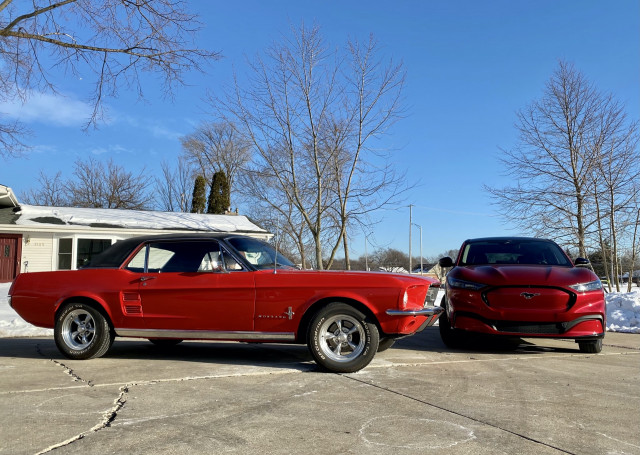
2021 Ford Mustang Mach-E and 1967 Ford Mustang coupe

2021 Ford Mustang Mach-E and 1967 Ford Mustang coupe
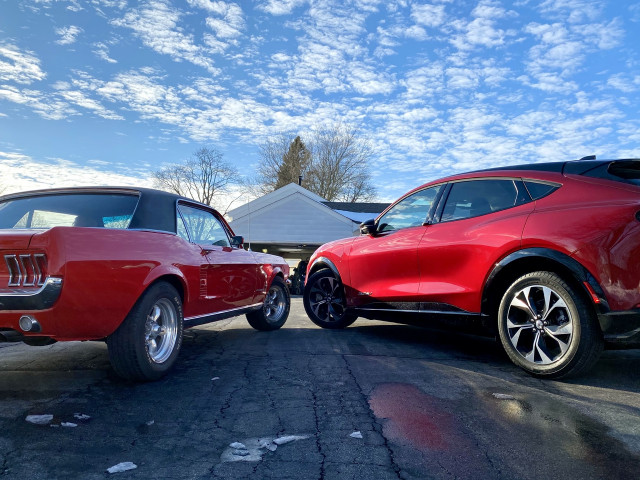
2021 Ford Mustang Mach-E and 1967 Ford Mustang coupe

2021 Ford Mustang Mach-E and 1967 Ford Mustang coupe
The battery packs stacked below the floor account for much of this dimensional generational difference.
The heaviness of the ‘67’s steel doors, its blockiness, the inefficient packaging, the rough and tumble rumble all suggest weight, but at 2,750 pounds it weighs nearly one ton less than the Mach-E’s 4,727-pound mass. Moving that much weight requires that much more power.
Both have rear-drive platforms, but the propulsion systems diverge on this evolutionary fork in the road. The ’67’s 289 cubic-inch small-block V-8 was optional. It made 225 hp and 170 lb-ft of torque from the factory and came with an available 3-speed “Cruise-O-Matic” automatic transmission. Three on the floor, not the tree.
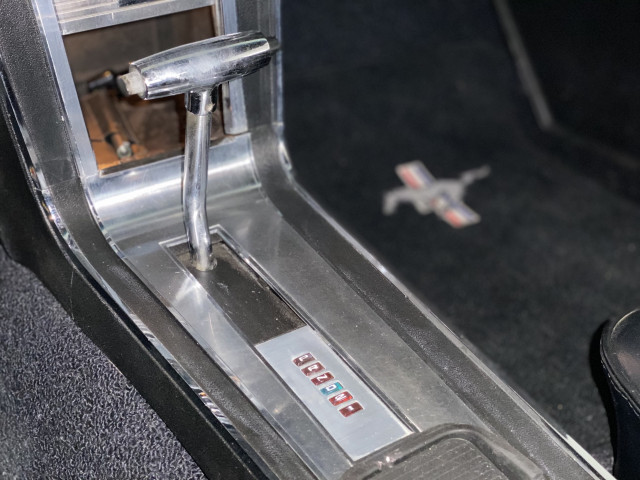
1967 Ford Mustang coupe
My Mustang Mach-E Premium AWD tester also had the larger available power source with an 88-kwh battery pack with dual-motor all-wheel drive and a single-speed transmission. Its 346 hp and 428 lb-ft of instant torque push the Mach-E to 60 mph in 4.8 seconds. I’m pretty sure, after five years of ownership, my dad’s Mustang is still striving to hit 60 mph. It redlines at 5,000 rpm, if you’re lucky.
Today, we’ve reached peak internal combustion engine. We’ve just begun with battery systems. One recedes, the other emerges.
Also in my dad’s garage is a BMW i3 electric pod with a range extender he drives 10 times more than the Mustang. For as much as he loves that small block V-8—he stained his fingers black working at his uncle’s service station in the ‘50s—he knows electric is the way forward.
It’s as easy for one generation to say there’s nothing like the V-8 rumble to rattle your bones and remind you you’re alive, as it is for another generation to say there’s nothing like instant torque and silent, emission-free operation to also remind you that you are still alive.

2021 Ford Mustang Mach-E and 1967 Ford Mustang coupe

2021 Ford Mustang Mach-E and 1967 Ford Mustang coupe

1967 Ford Mustang coupe
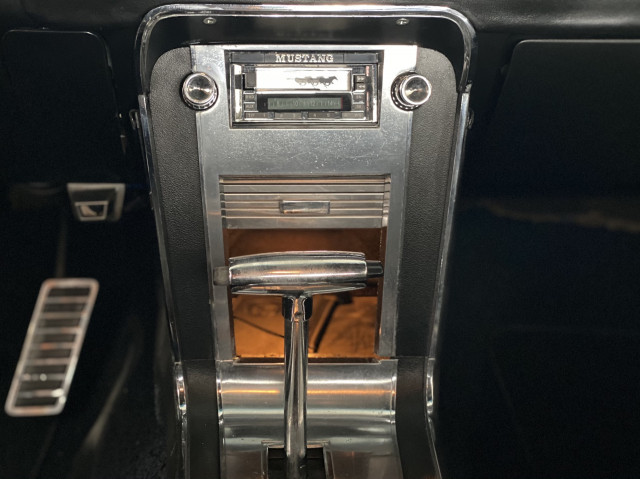
1967 Ford Mustang coupe
Our test loop consisted of a photo op in the driveway and down the block to charge the 12-volt battery and stir the fluids in the ’67. The steering wheel is wide and thin, the stalks are flimsy, the 3-speed keeps the revs high, and the smell of gas never really leaves the cabin, yet its charms are visceral. You feel everything and work for it. The recirculating ball steering has a painfully slow ratio of 20.3:1 and a lot of play on center. The Mach-E’s steering is snug and quick with a 14.6:1 ratio. Lock to lock in the Mustang might take as long as it does to get to 60 mph. The independent front and leaf spring rear suspension were cutting edge for the time, and even though it came with drum brakes from the factory, my dad’s car is upfitted with front disc brakes, which were optional back in the day.
Yet there’s something about classic cars like this ’67 Mustang that I admire, including front bucket seats shod in vinyl and a complete and utter lack of touchscreens. That’s not to disparage the Mach-E’s vertically oriented 15.5-inch touchscreen. It’s effective and easy to use, but touchscreens in general are a distraction at best and not worth the hassle at worst.

1967 Ford Mustang coupe

1967 Ford Mustang coupe

1967 Ford Mustang coupe
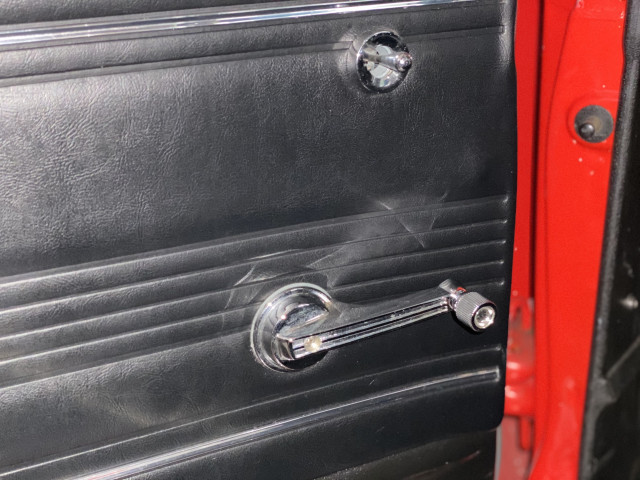
1967 Ford Mustang coupe
The ’67 has a pushbutton AM/FM radio with one-speaker. Of course, when you’re driving it, that’s all you’re driving it, not running errands, or stuck commuting, or doing the dozens of other things we do in cars. The clean dash and open floor lack distraction. Sure, it lacks connectivity and all these convenience features we apparently want because we keep paying for them. But simplicity in interior car design is as endangered as the V-8 engine, and in its place we get all the blings and zings, and glitz and shitz of the modern disposable marvel.
Ford approximates the open cabin feel with a fixed-glass roof and a small instrument bar in the Mach-E. The touchscreen is a concession to modernity. Vinyl isn’t too far removed from the past either, with a vinyl-wrapped heated steering wheel.
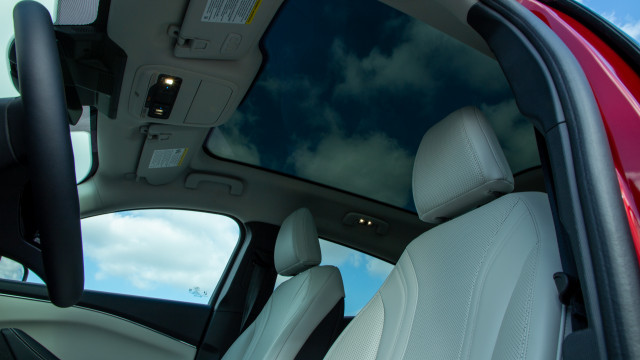
2021 Ford Mustang Mach-E

2021 Ford Mustang Mach-E

2021 Ford Mustang Mach-E
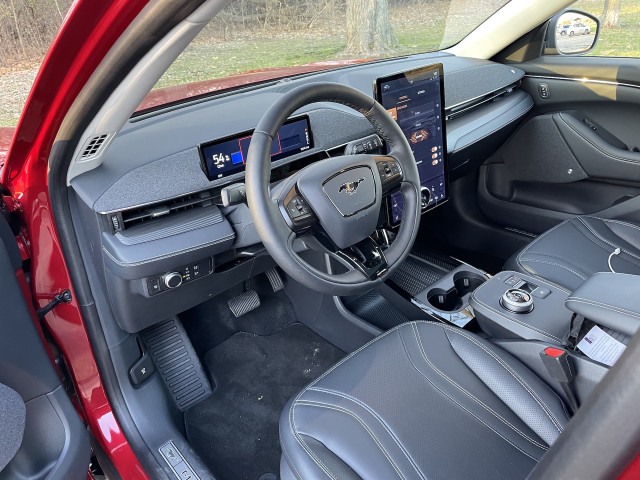
2021 Ford Mustang Mach-E
The Mustang Mach-E earns the Mustang name because cars evolve along with their human analogs. It celebrates the charms of the past without lingering there: There’s no going back, nor should we want to if we could. The Mach-E moves us forward, with all the affordable sport and style of its predecessor, and with gut-dropping acceleration and emission-free driving.
My dad loved the Mach-E. This fall, when his garage door opens, I won’t be surprised to see a Mustang with no tailpipes taking the place of the classic.

